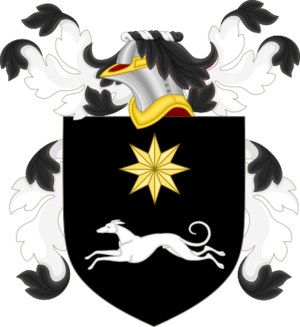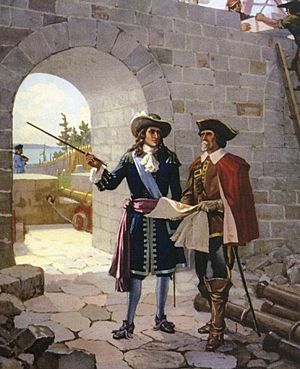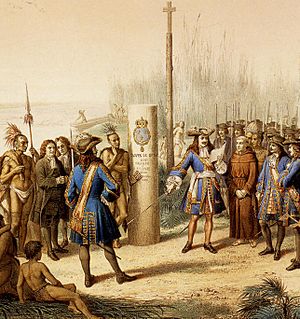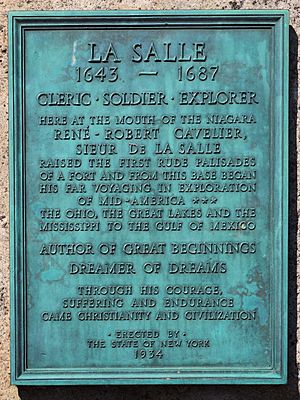René-Robert Cavelier, Sieur de La Salle facts for kids
Quick facts for kids
René-Robert Cavelier
|
|
|---|---|
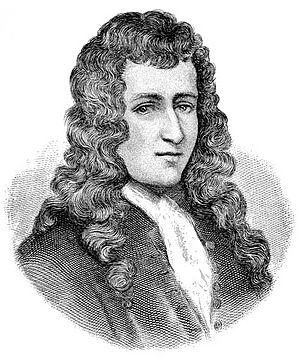
A 19th-century drawing of Cavelier de La Salle
|
|
| Born | November 22, 1643 |
| Died | March 19, 1687 (aged 43) present day Huntsville, Texas
|
| Nationality | French |
| Occupation | explorer |
| Known for | exploring the Great Lakes, Mississippi River, and the Gulf of Mexico |
| Signature | |
René-Robert Cavelier, Sieur de La Salle (November 22, 1643 – March 19, 1687) was a French explorer and fur trader. He lived in the 1600s and explored parts of North America. He traveled through the Great Lakes area in the United States and Canada. He also explored the Mississippi River.
La Salle is famous for his trip in 1682. He canoed down the lower Mississippi River. He went from the Illinois River all the way to the Gulf of Mexico. On April 9, 1682, he claimed the entire Mississippi River basin for France. He named this huge area La Louisiane. Some people say he gained the most fertile half of North America for France.
While Joliet and Marquette explored the upper Mississippi before him, La Salle explored much further. He extended France's claims all the way to the river's mouth.
Contents
Early Life and Becoming an Explorer
Robert Cavelier was born on November 22, 1643, in Rouen, France. His family was quite wealthy. When he was young, Robert loved science and nature. As a teenager, he studied with the Jesuit religious group. He became a member in 1660.
When he joined the Jesuits, La Salle had to give up his family's money. This made him very poor. In the spring of 1666, he sailed to New France (which is now Canada). His older brother, Jean, had moved there the year before. La Salle asked to leave the Jesuits in March 1667, after he arrived in Canada. He said he had "moral weaknesses."
La Salle was given land at the western end of the Island of Montreal. This land became known as Lachine. La Salle quickly started giving out land grants. He also set up a village and learned the languages of the local Iroquois Native people.
Understanding the Title: Sieur de La Salle
The name Sieur de La Salle is a French title. It means something like "Lord of the manor." A Sieur was a French noble title. It was similar to the English "Sir." However, in France, you could buy this title. It did not mean you had to do military duty.
Robert Cavelier took this title when he bought the land of Lachine around 1667. The name La Salle came from a family estate near Rouen. Over time, the name La Salle became strongly linked to him. People often called him Robert La Salle, or just "La Salle."
La Salle's Exciting Expeditions
Searching for a Western Passage
The Seneca Native people told La Salle about a big river called the Ohio. They said it flowed into a "Vermilion Sea." La Salle began to plan trips to find a western passage to China. He got permission from Governor Daniel Courcelle and Intendant Jean Talon. He sold his land in Lachine to pay for these trips.
La Salle left Lachine on July 6, 1669. He had nine canoes and 24 men. They traveled up the St. Lawrence River and across Lake Ontario. After 35 days, they reached Irondequoit Bay. This place is now called La Salle's Landing.
At a Native village, the Seneca tried to stop them from going into the lands of their enemies, the Algonquins. They said bad things would happen. This delayed the trip for a month. La Salle got sick with a fever and decided to return to Ville Marie.
Building Forts in the Great Lakes
On July 12, 1673, the Governor of New France, Louis de Buade de Frontenac, met with leaders of the Five Nations of the Iroquois. They met at the mouth of the Cataraqui River. Frontenac wanted them to trade with the French. While they met, La Salle and his men quickly built a rough wooden fort. It was first called Fort Cataraqui. Later, La Salle renamed it Fort Frontenac to honor the Governor.
Fort Frontenac was built to control the valuable fur trade in the Great Lakes area. It also helped protect against the English and Dutch, who also wanted control of the fur trade. La Salle was put in charge of the fort in 1673.
La Salle traveled to France in 1674–75. He got control of Fort Cataraqui and also received a noble title. With Governor Frontenac's help, he also got permission to set up more forts for the fur trade. He returned and rebuilt Fort Frontenac using stone. An Ontario Heritage Trust plaque says La Salle was important for expanding the French fur trade. He used the fort to explore west and southwest. Henri de Tonti joined him as his assistant.
In December 1678, La Salle and Henri de Tonti were the first Europeans to see Niagara Falls. They built Fort Conti at the mouth of the Niagara River. They loaded supplies into smaller boats to go up the shallow Niagara River. This led to what is now Lewiston, New York. The Iroquois had a path there to get around the rapids and the waterfall.
La Salle's first ship, the Frontenac, was lost in Lake Ontario in January 1679. After that, La Salle built Le Griffon. This ship had seven cannons and weighed 45 tons. It was launched on August 7, 1679, on the upper Niagara River.
La Salle sailed Le Griffon up Lake Erie to Lake Huron, then to Michilimackinac, and on to Green Bay, Wisconsin. Le Griffon left for Niagara with furs but was never seen again. La Salle continued with his men in canoes. They went down the western shore of Lake Michigan. They rounded the southern end to the mouth of the Miami River (now St. Joseph River). There, they built a fort in January 1680. They called it Fort Miami (now St. Joseph, Michigan). They waited there for Tonti and his group.
Exploring the Mississippi River
On December 3, 1679, La Salle and Henri de Tonti headed south from Fort Conti. They canoed up the St. Joseph River. They then carried their canoes across land to the Kankakee River. They followed this river to the Illinois River. In January 1680, they reached an area near what is now Peoria, Illinois. To help the local Peoria tribe against the Iroquois, La Salle built a fort called Fort Crèvecoeur.
La Salle left on foot to get supplies from Fort Frontenac. While he was gone, the soldiers at Fort Crèvecoeur rebelled. They destroyed the fort and forced Tonti, who was in charge, to leave.
The group later traveled along the Illinois River. They reached the Mississippi River in February 1682. They built canoes there. The exploration reached an area that is now Memphis, Tennessee. La Salle built a small fort there called Fort Prudhomme. This was the first French building in Tennessee.
In April 1682, the expedition reached the Gulf of Mexico. There, La Salle named the Mississippi basin La Louisiane. He did this to honor King Louis XIV and claimed the land for France.
From 1682 to 1683, La Salle and Henry de Tonti built Fort Saint-Louis at Starved Rock on the Illinois River. This fort was meant to protect the region for France. La Salle then went back to Montreal and later to France.
Texas Expedition and La Salle's Death
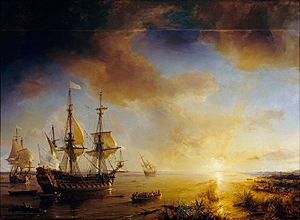
On July 24, 1684, La Salle left France. He returned to America with a large group. His plan was to start a French colony at the mouth of the Mississippi River. They had four ships and 300 colonists. The trip faced many problems. These included pirates, Native people defending their land, and bad navigation.
One ship was lost to pirates in the West Indies. A second ship sank in Matagorda Bay. They started a settlement near the bay. They called it the Bay of Saint Louis. It was on Garcitas Creek, near what is now Victoria, Texas. La Salle led groups on foot three times to try and find the mouth of the Mississippi. Meanwhile, the main ship, La Belle, ran aground and sank. This left the colony stranded on the Texas coast.
During a final search for the Mississippi River in 1687, La Salle got lost. Some of his men rebelled near what is now Navasota, Texas.
On March 19, 1687, La Salle was killed by Pierre Duhaut. This happened during an ambush. Duhaut was described as a "disenchanted follower." Duhaut was later shot and killed by James Hiems. The colony only lasted until 1688. Then, Karankawa-speaking Native people killed the remaining adults and took five children captive. Tonti sent search missions in 1689 but found no survivors.
La Salle's Personal Life
La Salle never married. However, he has been linked to Madeleine de Roybon d'Allonne, an early colonist in New France.
La Salle's Lasting Legacy
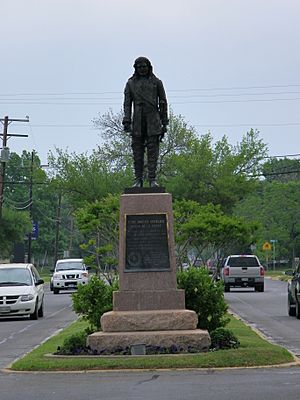

La Salle built forts that helped with the fur trade. His visits to the Illinois and other Native groups helped France make alliances with them. This helped to control the influence of the Iroquois and stop English and American colonization.
He also named the large area he claimed for France Louisiana. This name lives on in the U.S. state today.
The Encyclopædia Britannica says that La Salle's claim of Louisiana for France, even if it was just a boast at the time, showed the way for the French to build a colonial empire later on.
Pierre Berton wrote that La Salle's life was full of adventure, triumphs, and heartbreaks. Even though he died in the lowlands of the Gulf of Mexico, he was truly a man of the Great Lakes.
A statue of de La Salle is on the south side of the Knute Rockne Memorial at the University of Notre Dame.
Archaeological Discoveries
In 1995, La Salle's main ship, La Belle, was found in the mud of Matagorda Bay. It has been studied by archaeologists. From 1996 to 1997, many items from the 1600s were found from the wreck and nearby area. An international agreement means that France owns these items. They are kept safe by the Texas Historical Commission. The collection is at the Corpus Christi Museum of Science and History. You can see items from La Belle at nine museums across Texas.
His other ship, L'Aimable, has not been found yet. In 1998, a group said they found the wreck in Matagorda Bay. However, the Texas Historical Commission said it was a much newer wreck.
Possible remains of Le Griffon were found in 1898. This was by a lighthouse keeper on Manitoulin Island in northern Lake Huron. The results of testing some items were debated. Many of the found items were lost, and the wreck was washed away in 1942. Another possible shipwreck of Le Griffon was found in 2001. This was near Poverty Island at the entrance to Green Bay. In 2019, the Discovery Channel showed a story about the ship. Divers involved in the search believed Le Griffon sank in the Mississagi Strait.
Historians also debated where La Salle's "Fort St Louis" colony was. It was thought to be near Lavaca Bay at Garcitas Creek. This fort was a big part of the history of French colonization of Texas. In June 1996, a dig at the believed location found eight French cannons. This led archaeologists to dig at the Keeran Ranch site from 1996 to 2002. They concluded that the Spanish Presidio La Bahía fort was built on top of La Salle's settlement. About 10% of the items found are thought to be from France.
Places Named After La Salle
Many places, streets, parks, and buildings are named in honor of La Salle:
Counties and Towns
- LaSalle, in Essex County, Ontario, Canada
- LaSalle, Quebec is a part of Montreal, Quebec, Canada.
- LaSalle County, Illinois, the city of LaSalle and the La Salle Speedway there.
- LaSalle Parish, Louisiana
- La Salle County, Texas
Parks and Streets
- The LaSalle Expressway, a road in Niagara Falls, New York.
- LaSalle Street, a main street in Chicago, which is the center of Chicago's financial area.
- The La Salle Causeway, connecting Kingston, Ontario to Barriefield, Ontario.
- Jardin Cavelier de La Salle in Paris, France.
- La Salle Avenue, a downtown street in Minneapolis, Minnesota.
- Avenue La Salle, in Shawinigan, Quebec, Canada.
- La Salle Street in Navasota, Texas. It has a statue given by local groups.
- Lasalle Road, a road south of Sarnia, Ontario, Canada.
- LaSalle Avenue, a main road in South Bend, Indiana.
- LaSalle Boulevard and Cavelier Road in Marquette Heights, Illinois, near Fort Crèvecoeur.
- La Salle Avenue in Waco, Texas.
- La Salles Landing Park on Irondequoit Creek in Penfield, NY.
- La Salle Park in Burlington, Ontario.
- Robert LaSalle County Park, Door County, Wisconsin.
Buildings and Other
- LaSalle car brand.
- LaSalle-Peru Township High School in LaSalle, Illinois. Their mascot is the Cavaliers.
- La Salle Hotel, Chicago.
- LaSalle Hotel in downtown Bryan, Texas.
- École secondaire publique De La Salle in Ottawa, Ontario.
- La Salle Secondary School in Kingston, Ontario.
- De La Salle High School in New Orleans, Louisiana.
|
See also
 In Spanish: René Robert Cavelier de La Salle para niños
In Spanish: René Robert Cavelier de La Salle para niños


